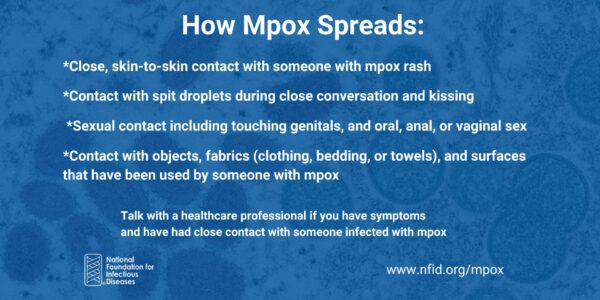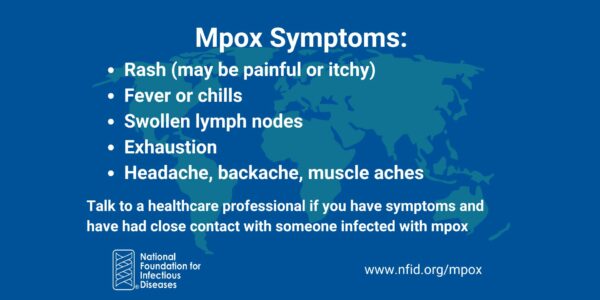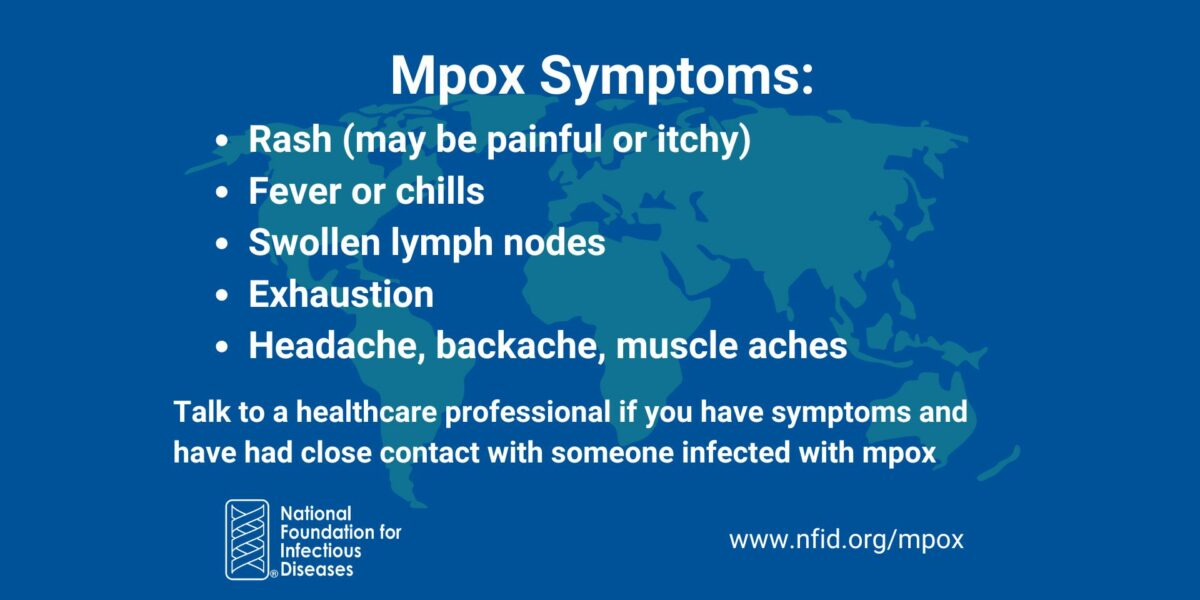
What is Mpox?
Mpox (previously known as monkeypox) virus belongs to the Orthopoxvirus genus which also includes variola virus (which causes smallpox), vaccinia virus (used in the smallpox vaccine), and cowpox virus, among others.
Transmission occurs when an individual comes into contact with the virus from an animal, human, or materials contaminated with the virus. The virus enters the body through broken skin (even if not visible) or through the respiratory tract (eyes, nose, or mouth). Human-to-human transmission is thought to occur primarily through skin-on-skin, intimate personal contact. The virus also can be transmitted by large respiratory droplets requiring prolonged face-to-face contact.
The natural reservoir of mpox remains unknown. However, African rodents and non-human primates (like monkeys) may harbor the virus and infect people.

Burden
Mpox was first discovered in 1958 when two outbreaks of a pox-like disease occurred in colonies of monkeys kept for research. The first human case was recorded in 1970 in the Democratic Republic of the Congo during a period of intensified effort to eliminate smallpox. In Africa, mpox has been shown to cause death in as many as 1 in 10 persons who contract the disease.
According to the Centers for Disease Control and Prevention (CDC), rates of mpox in the US are below the peak of the outbreak in 2022. CDC recommends that people who are at risk for mpox and eligible for vaccination get vaccinated.
Symptoms
In humans, the symptoms of mpox are similar to, but milder than, the symptoms of smallpox. Mpox symptoms include:
- Rash on the hands, feet, chest, face, mouth, or on or near the genitals or anus. The rash may start out looking like pimples or blisters and may be painful or itchy.
- Fever or chills
- Swollen lymph nodes
- Exhaustion
- Muscle aches, backache, headache
- Respiratory symptoms (e.g., sore throat, nasal congestion, or cough)
Symptoms usually start within 3 weeks of exposure to mpox. Within 1 to 3 days (sometimes longer) after the appearance of fever, the infected individual develops a rash. The rash can appear anywhere on the body, often on the trunk, genitals, or buttocks. The illness typically lasts for 2−4 weeks.
A person with mpox can spread it to others from the time symptoms start until the rash has fully healed and a fresh layer of skin has formed. Some people can spread mpox to others from 1-4 days before their symptoms appear.

Prevention
Vaccination is an important tool in preventing the spread of mpox. In addition, mpox infection can be prevented by:
- Avoiding close, skin-to-skin contact with the mpox rash
- Avoiding contact with objects and materials that a person with mpox has used (such as bedding, towels, clothing, or eating utensils or cups)
- Washing hands with soap and water or using an alcohol-based hand sanitizer after contact with infected animals or humans
- Avoiding contact with animals that could harbor the virus (including animals that are sick or that have been found dead in areas where mpox occurs) and any materials that have been in contact with a sick animal
- Isolating infected patients from others who could be at risk for infection
CDC recommends vaccination for people who have been exposed to mpox or may be more likely to get mpox. JYNNEOSTM, an attenuated live virus vaccine, is effective in protecting people against mpox. Vaccine supply is limited but vaccines may be available through state and local health departments.
Mpox is often transmitted through close, sustained physical contact, almost exclusively associated with sexual contact in the current outbreak. Condoms can help protect against mpox but may not prevent all exposures because the rash can occur on other parts of the body. CDC recommends limiting the number of sexual partners to reduce the risk of exposure. If you or a partner think you may have mpox, avoid kissing, touching, or sex of any kind (oral, anal, or vaginal) while you are sick.
Treatment
Currently, there is no proven, safe treatment for mpox virus infection, and treatment focuses on relieving symptoms. Pain management is critical. The majority of patients recover from mpox, but it may take 2-4 weeks for the rash to disappear.
Vaccines (JYNNEOSTM and ACAM2000®), antivirals, and vaccinia immune globulin (VIG) may be used to control the Mpox outbreak in the US. An experimental antiviral drug (tecovirimat or Tpoxx) is available in the US under “compassionate use.”
If you think you may have mpox, talk to a healthcare professional as soon as possible.
Updated March 2023
Source: Centers for Disease Control and Prevention
Related Resources

What Is an Antiviral?
Overview of antivirals—what they are, how they work, and what diseases they help treat

Leading with Passion and Purpose—Demetre C. Daskalakis, MD, MPH
S3, E3: Demetre C. Daskalakis, MD, MPH, shares his journey from HIV clinical practice to public health leadership, demonstrating his relentless passion and commitment to health equity, clear and transparent communication, and ensuring equitable access to vaccines for all children and adults …
Related Posts

ID News Round-Up: Monkeypox
Since May 2022, an outbreak of monkeypox has been ongoing in several countries, including the US. As of August 2022, US health officials have confirmed thousands of cases, in all 50 states. Read recent news of interest from the world of infectious diseases, with a focus on monkeypox …
